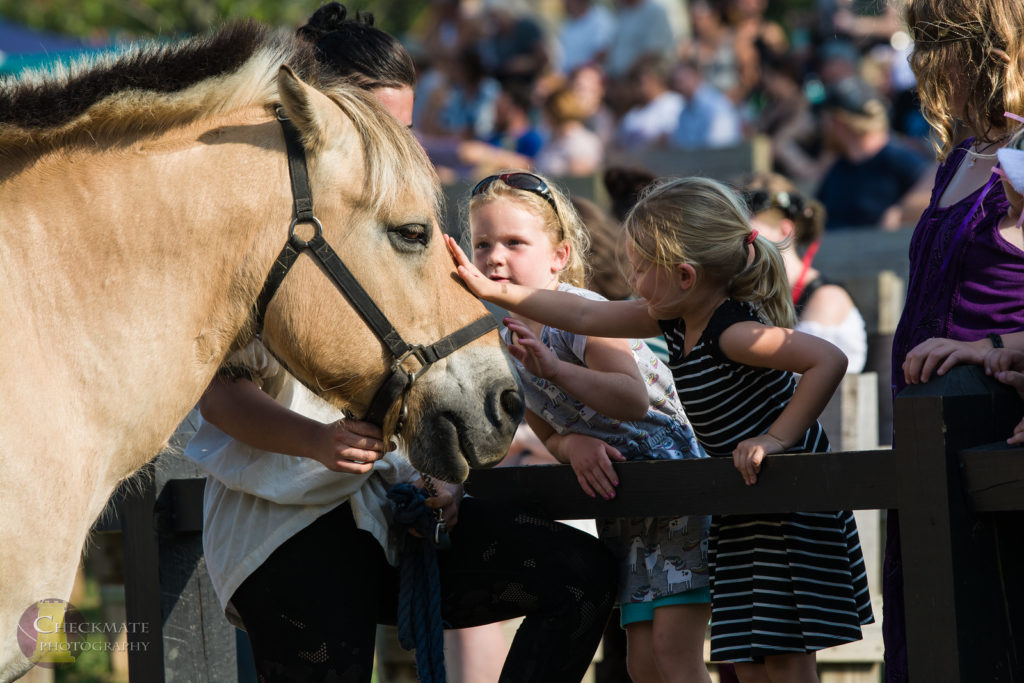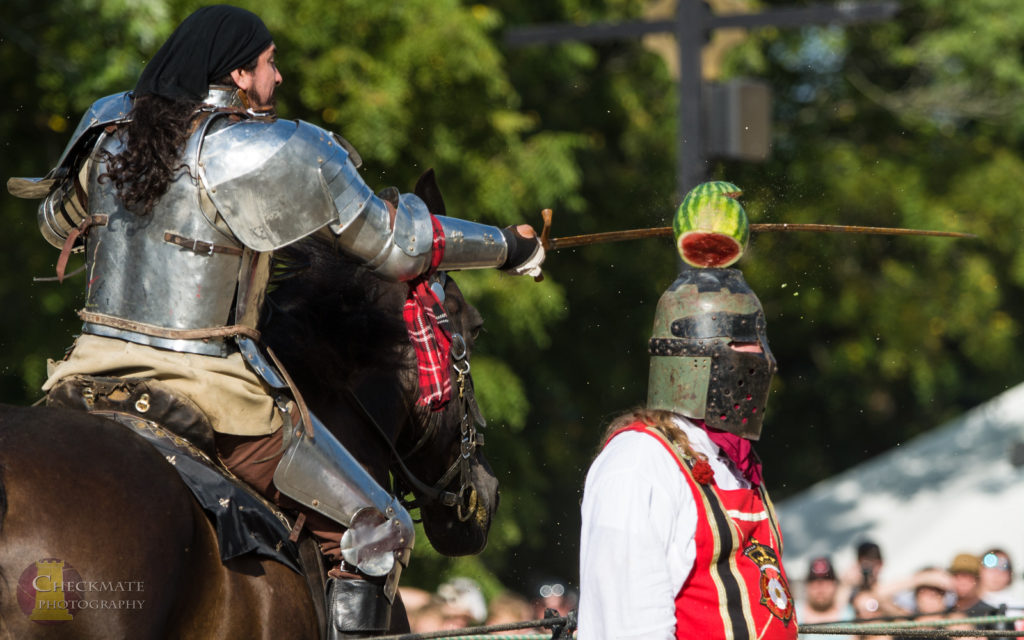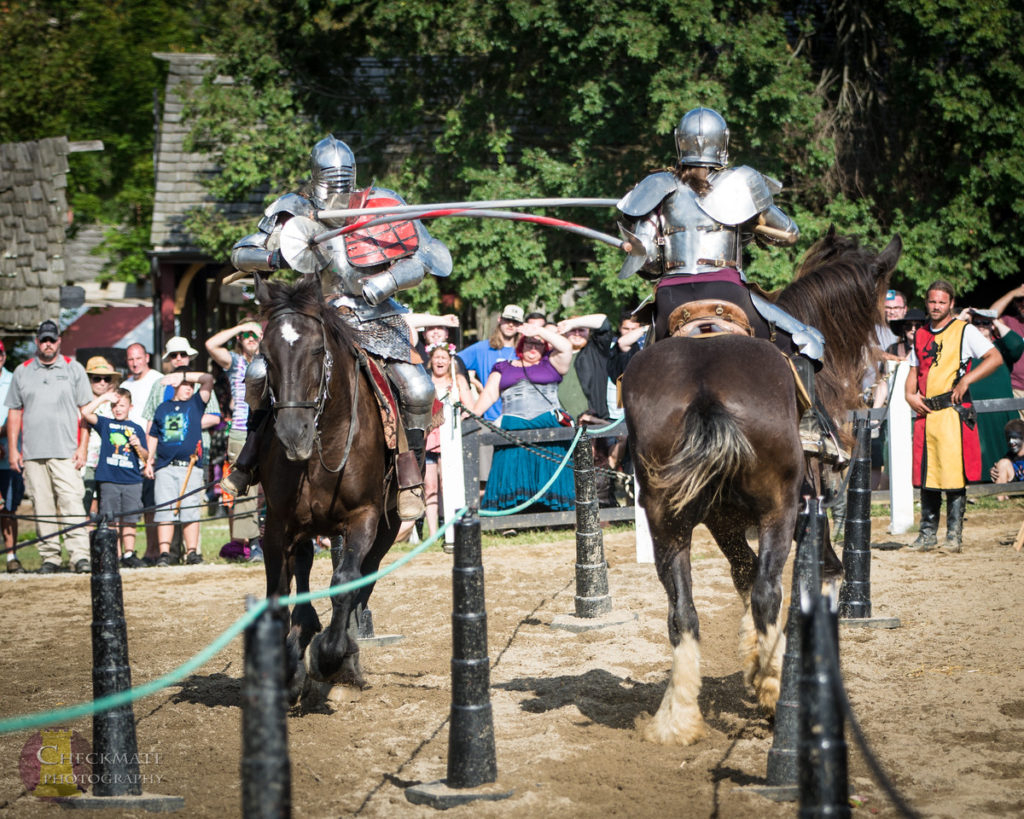Ah jousting. The NASCAR of Old World. Take that joke with a grain of salt. I love going to watch the jousts at ORF, and apparently so does everyone else. Every joust has been packed to standing room only and the people who attend are very enthusiastic as the jouster rousters get them pumped for the show.
Jouster rousters – (Noun) Cast members who help get the crowd ready and let them know which knight to cheer for.

Jousting has existed since at least the 1300s. It is said to have developed from the military skill of the heavy cavalry and began as a way of knights to train during peacetime. It should be noted that jousting is not limited to charging towards one another on horseback with a lance. It often includes a display of armed combat skills on foot with a variety of weaponry. A popular sport both among the nobility of England, Wales, Germany, and France, it remained as such until the 1700s, when it was discontinued due to changing social norms in favor of other equestrian sports.
Since the 1970s jousting has enjoyed a resurgence due to a renewed interest in the sport along with the revival of the renaissance festivals. With so much about old-world jousting having been lost to time, the sport had to be rebuilt from the ground up. Over time it became a competitive sport once again, with trained and practiced knights competing on the lists.
List – (noun) The lists, or list field, was the arena where a jousting event was held. More precisely, it was the roped-off enclosure where tournament fighting took place (Source: Wikipedia)
Jousting at Ohio Renaissance Festival
There are two general types of jousting companies:
Theatrical – choreographed shows where the actions are performed as live theater with trained stunt performers and actors.
Full-Contact – trained equestrians and combatants in full armor competing to move up in the ranking of a sport.

It should be noted that both forms require a huge amount of dedication and coordination from their performers. A theatrical performer still risks injury if something goes wrong, and a full-contact athlete still has to go out and provide a good show to the audience. I don’t bring up the differences to disparage either one, I only do so to make one aware that there is a difference between a theater joust versus a competitive sport.
The Ohio Renaissance Festival is very lucky to have the full-contact jousting troop the Knights of Valour attend the festival every year. Many people are under the assumption that the show is a stunt performance, and that the joust scripted. This could not be further from the truth. The KoV are a full-contact jousting troop and helped found World Championship Jousting Association (WCJA) which strives to have jousting acknowledged as a combat sport.
I love the horses and the excitement. it’s one of my favorite parts of faire and I’ve been a fan since the days when Sir Chanton jousted.”
Susan Morriss.
They continue to be one of the biggest draws for the festival, and the show only gets better with Premium Jousting Seats for the best (and most shaded) view. Along with the wild ride down the lists, kids and adults alike can enjoy a ride on one of the War Horses after the joust. Each horse is a rescue animal, cared for and trained by the knights themselves and each one of them is a spoiled sweetheart.

The 2019 season made for an especially amazing round of jousts! With a new show full of spectacles and performances, the KoV were bringing their A-game and giving the people a little more of a show along with their full-contact rides. The show begins with an introduction of the knights competing for the day. Each knight has their own unique personality and backstory, from the Spaniard to the Black Knight, and many long-time fans have their favorite. The knights then each take a rose and offer it a lady in the audience so they can joust for her honor.
I always enjoy it. The premium seating near her Her Majesty is definitely worth it. I did that on the second-to-last Sunday and saw a double unhorsing. I also ended up with a 30th anniversary ORF pin.”
Justin Risner
They begin with some warm-up events, wherein the knights must lance a ring from a person’s hand, or nail a spear in the center of a target all for points which will help determine the winner. One of the shows includes a daring volunteer who will stand very VERY still as a knight slices a small watermelon off their head! A nerve-racking display of talent and precision, but so far everyone has survived the experience. Each time a knight wins an event, they are given a handful of ‘gold’ (butterscotch candies) which they throw out to their adoring crowd.

As the tension builds, it is finally time for the joust itself to begin. The knights are assisted by their squires to ensure their armor is on correctly. As they are handed their lances you can sense the tension of their mounts as they get ready to run. A hush falls over the crowd as the two go barreling down the lists at one another. Every miss gets a disappointed sigh, but a good strike against one’s opponent is met with cheers and applause. And if someone gets un-horsed there is a joined “OUH!” from the stands followed by loud applause as the brave knight rises.

Three passes is the usual standard, with the best two out of three declared the winner. But if there is a tie, then a fourth or fifth pass it not unknown! The winner receives the adoration of the crowd and the thrill of knowing they are the victor of the day!
This year, the KoV decided to try some new things out, bringing forth more combat as the knights went toe to toe with sword and shield for the excitement of the guests. This new layer got a warm reception, with people standing up in their seats to get a good view of the action as the knights fought for their honor and pride. It was an interesting change-up, and I enjoyed seeing more of the skill and precision it takes to do this on an athletic level.
Jousting is an intensely competitive sport, with its own rules, ranking, and international recognition. As this ancient pastime gains in popularity, it encourages a passionate dedication from the men and women who have put so much into riding high against all odds. The 2019 season was a stunning reminder of their capabilities, and I can’t wait to see what 2020 will bring!
